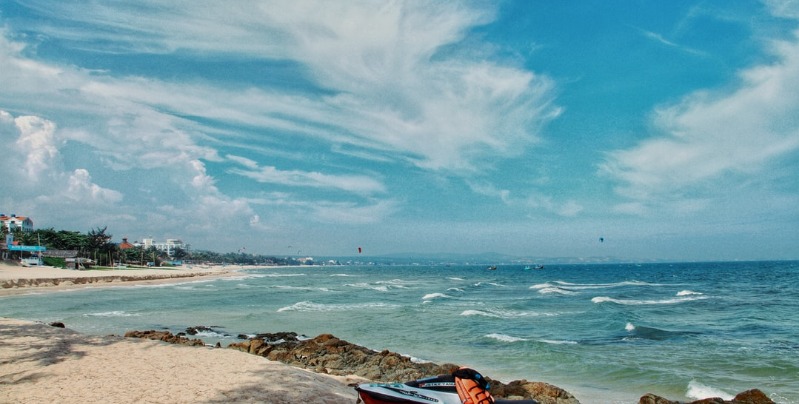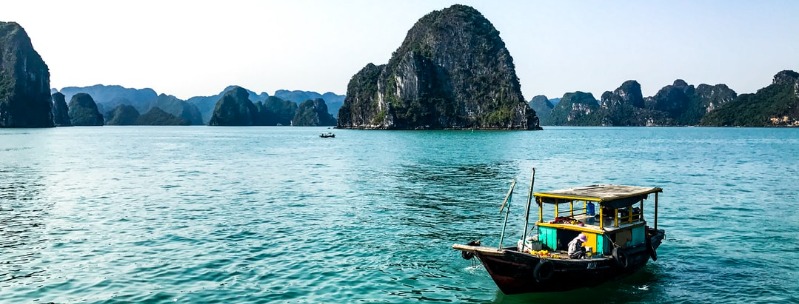Best Vietnam Beaches 2024
As the number of tourists finding their way here soars, the word is out that this is a land not of bomb craters and army ordnance, but of shimmering paddy fields and sugar-white beaches, full-tilt cities and venerable pagodas.
For the majority of visitors, the furiously commercial southern city of Ho Chi Minh City provides a head-spinning introduction to Vietnam, so a trip out into the rice fields and orchards of the nearby Mekong Delta makes a welcome next stop – best explored by boat.
Heading north, the quaint hill-station of Da Lat provides a good place to cool down, but some travelers eschew this for the beaches of Vung Tau and Phan Thiet.
China Beach
between Da Nang and Hoi An
The name “China Beach” is apparently an invention of American television, but this 20 mile stretch of sand near Danang really was used by American soldiers as an “R&R;” stop.
The weather here is quite cool in the winter, but from April or May until August it can be quite nice. The beach was the site of Vietnam’s first international surfing competition in 1992. Conditions for surfing are best from September to December.
The main beach is officially around the Non Nuoc Resort hotel but some locals argue that the real China Beach is at My Khe Beach about 5 km north of the hotel [both are near the tourist attraction of Marble Mountains].
Nha Trang Beaches
Nestled below the bottom lip of the Cai River, some 260km north of Phan Thiet, Nha Trang has earned its place on Vietnam’s tourist mainline partly on merit and partly owing to its location.
By the time the Nguyen lords wrested this patch of the country from Champa in the mid-seventeenth century, the intriguing Po Nagar Cham towers had already stood, stacked impressively on a hillside above the Cai, for over 700 years.
They remain Nha Trang’s most famous image, yet it’s the coastline that brings tourists flocking: the town boasts the finest municipal beach in Vietnam, scuba-diving courses are available here, and there are plenty of day-trips to outlying islands too.
Most new arrivals in the city make a beeline for the municipal beach, a grand six-kilometer scythe of soft yellow sand that’s only five minutes’ stroll east of Cho Dam market.
Perhaps the single greatest pleasure of a stay in Nha Trang is a day-trip to one of the nearby islands, best reached on one of the popular day-trips organized by the tour operators listed opposite. It’s also possible, though pricey, to charter your own boat from Cau Da Wharf, 6km south of Nha Trang.
The closest of the islands to Cau Da, Hon Mieu, is served by a local ferry (15min) which docks at Tri Nguyen, a fishing village, from where it’s a few minutes’ walk to Tri Nguyen Aquarium, a series of saltwater ponds constructed for breeding and research purposes and a small indoor aquarium.
Southeast of the aquarium there’s a shingly beach at the fishing village at Bai Soai. The shallows that ring Hon Tam , 2km southeast of Mieu, are good for snorkelling. Hon Tre ‘s cliffs lend a welcome dash of drama to this, the largest of Nha Trang’s islands, and offset the fine white sand of its beach, Bai Tru.
Two smaller isles hover off Hon Tre’s southern coast: Hon Mot has a stony beach but good snorkelling; Hon Mun harbors caves where sea swifts’ nests are harvested and sold at thousands of dollars per kilo for use in birds’ nest soups. There’s no beach to speak of on Mun, but some great coral.
Phan Thiet Beach
More and more foreigners are discovering Phan Thiet ‘s hidden charms, and this friendly fishing port now looks set to become one of the stepping stones between Ho Chi Minh and Hanoi, not least because of its proximity to wonderful Cape Mui Ne, a 21-kilometre-long arc of fine sand.

Quaint colonial villas season Phan Thiet’s main streets, some decorated with glazed ceramic tiles, most with louvred windows and colonnaded facades. Turn left off the southwestern end of Tran Hung Dao Bridge, and stroll along Trung Trac, and you’ll soon plunge into the wharfside fish market.
Back in the other direction, Trung Trac skirts the city centre en route to the riverside Ho Chi Minh Museum, rather a flat museum, but with some nicely quaint memorabilia. A couple of hundred metres south on Tran Phu, Ong Pagoda also merits a browse.
Over Tran Hung Dao Bridge, Vo Thi Sau strikes off to the right and to the city beach which, 700m northeast, opens out into a nice pine-shaded spot.
At the head of every Phan Thiet itinerary should be the jaunt out east along Thu Khoa Huan towards Cape Mui Ne – a trip rewarded by mile after mile of palm-shaded golden sand, lapped by clear waters. The beach commences soon after you’ve crossed Ke Bridge and passed the Phu Hai Cham towers, but the best stretch starts around 12km out of Phan Thiet, after which the coconut trees give way to the impressive red dunes for which this area is famous.
Open-tour buses now run through Mui Ne en route from Nha Trang or Ho Chi Minh, stopping at Ha Phuong Tourist Company office (Hanh cafй), located at Km14, Ham Tien. Alternatively, a Honda om from Phan Thiet should cost around $2 each way. Some of the resorts have provision for windsurfing, sailing, mountainbiking and motorbiking.
Phu Quoc Island
According to many, the beaches of Phu Quoc island are the best in Vietnam. The island lies off Kampot in Cambodia and is in fact claimed by Cambodia.
Phu Quoc Island in the Gulf of Thailand is Vietnam’s largest island. Off Ha Tien, it is one a hidden gem of Southeast Asia.
The island has mountains, forests and superb sandy beaches perfect for nature lovers as well as sun-seekers.
Vung Tau Beaches
With every passing day, a little more of the charm ebbs from Vung Tau, “The Bay of Boats”, located some 125km southeast of Ho Chi Minh City on a hammerheaded spit of land jutting into the mouth of the Saigon River. Once a thriving riviera-style beach resort, the city is now a shadow of its former, quaint self. Today, Western oil-workers nurturing the city’s burgeoning oil industry are a common sight around town, and a slather of bars and massage parlours have sprung up to cater for them. That said, as a retreat from the frenzy of Ho Chi Minh, Vung Tau is worth considering.
Downtown Vung Tau nestles between two diminutive peaks, Nui Lon (“Big Mountain”) to the north, and Nui Nho (“Small Mountain”) to the south. Roads loop around both, and these circuits take in all of the city’s beaches – quiet, northerly Bai Dau, blustery Bai Dua, and Bai Sau, or “Back Beach”, which has the city’s best sands. Between them runs Bai Truoc (“Front Beach”), Vung Tau’s skinny municipal beach. Many prefer to push on to more intimate Long Hai, just 20km around the coast.
The skinny strip of litter- and rubble-strewn town beach, Bai Truoc or Front Beach is ribbed by souvenir shops, bars and restaurants and of most interest at dawn and dusk when fishermen dredge its shallows.
The foot of Quang Trung is the starting-block for the six-kilometre circuit of Nui Nho . From there, the exposed coastal road, Ha Long, loops around the southside of the mountain. The most noteworthy of several pagodas strung along this stretch of coastline is Niet Ban Tinh Xa Pagoda (daily 7am-5pm), a modern and multi-level complex fronted by a structure resembling a high-rise dovecote. Bai Dua , south of the pagoda, is a composite of shingle, dark sand and rocks, so if you want a swim or a sunbathe, hold on until you round the promontory. Meanwhile, a gruelling fifteen-minute hike from the southwestern tip of Nui Nho brings you to Vung Tau’s own little touch of Rio, its 33-metre-high Giant Jesus (daily 7.30-11.30am & 1.30-5pm). Climb the steps inside the statue and you’ll enjoy giddying views. Immediately around the headland is the sweet, sandy cove of Bai Nghinh Phong , and beyond that, Hon Ba Temple marooned a little way out to sea on a tiny islet, accessible only at low tide.
Despite its ugly block-buildings and proposed development, Bai Sau , or Back Beach , is far and away Vung Tau’s widest, longest (8km) and best beach. Hoang Hoa Tham cuts around the north side of Nui Nho to reach the city centre. En route, you might check out Lang Ca Ong , or Whale Temple. According to Cham folklore, the whale was a sacred creature, and protector of seafarers; three glass cabinets behind the altar are filled with the bones of whales washed up on the shore.
North of Bach Dinh, sleepy Bai Dau is the most hassle-free of all Vung Tau’s beaches. Barring the odd restaurant, there’s very little action here, but heavy stone walls and blue-shuttered buildings lend it a Mediterranean ambience. The actual beach is short, dark and slightly pebbly, but still suitable for swimming. With a bicycle you could continue north from Bai Dau to the leaf-roofed stilthouses of the delightful fishing village of Sao Mai . Further clockwise, Sao Mai blends into the busy quayside of bigger Ben Dinh .
